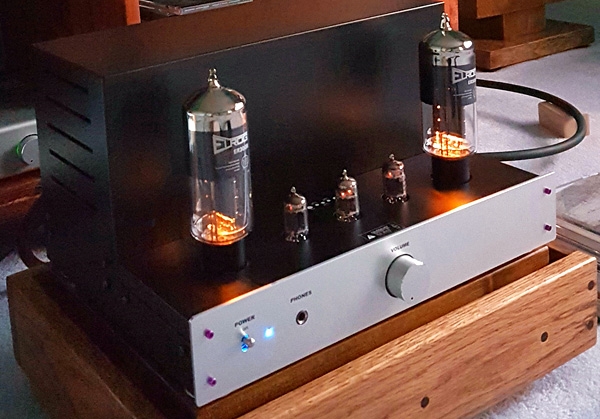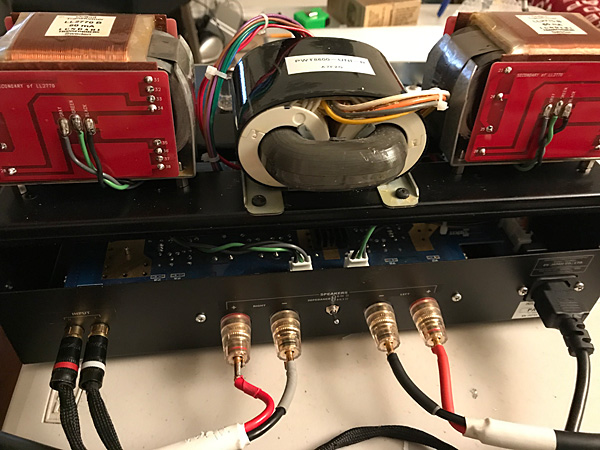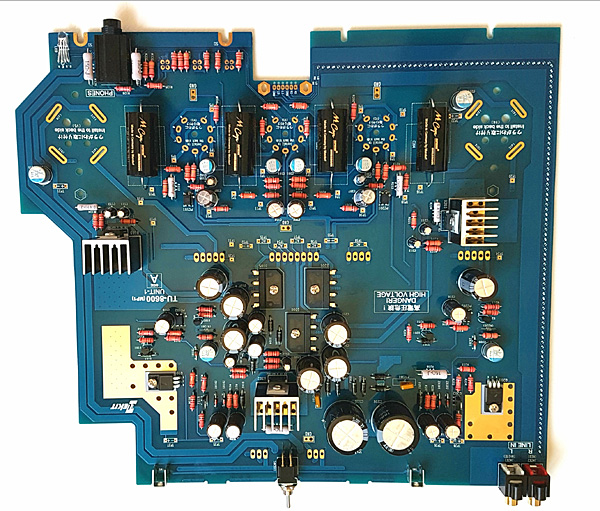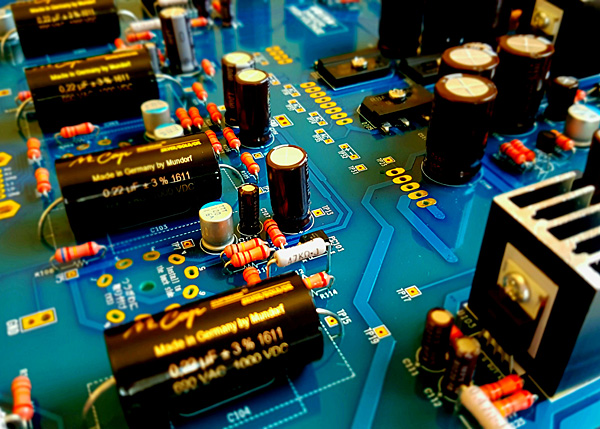| Columns Retired Columns & Blogs |
Don't get filthy now...
If they build it, I will come.

In 1988 I had my first experience with Western Electric 300B tubes. It took place on a quiet, streetlights-and-snow night at my friend Ryoichi's apartment on Riverside Drive, in Manhattan.
I had never heard of the late Japanese amplifier designer Ken Shindo, of Shindo Laboratory. But that evening, Ryo's audio system was all Shindo: a hammertone gray Shindo-restored, grease-bearing Garrard 301 turntable sitting on a Shindo plinth of glossy wood, with a Shindo-modified Ortofon tonearm and SPU cartridge, a Shindo moving-coil step-up transformer, and a Shindo preamplifier with a moving-magnet phono stage. All of this, plus a pair of incredibly beautiful, single-ended Shindo amplifiers equipped with new-old-stock (NOS) Western Electric 274A and 300B tubes. Red cloth-covered NOS Western Electric wires connected the Shindo amps to a pair of Altec 604-B drivers in vintage Altec 612 cabinets.
Set against the Shindo-green monoblocks, the yellow lettering on the WE tubes looked like the finest industrial art. The gray-enameled Altec cabinets exuded pro-style coolosity. When Julie London began singing "Cry Me a River," from Julie Is Her Name (LP, Liberty LRP 3006), I smiled my oh-my-god smile and slumped into the sofa. The clarity of sound riveted my brain. No previous audio experience had prepared me for the liquid radiance or breathy human clarity of what I heard happening in front of me.
No Darth Vader speakers, no war-machine amps, no cables from the cartel: just Julie and me, practically kissing.
When she stopped, I realized that these power amplifiers had reproduced every moving molecule between London's mouth and the recording microphone. I already knew that directly heated triodes sounded more vivid and less mechanical than pentodes or transistors—I'd already hot-rodded a Dynaco Stereo 70 (the Ford Model A of tube amps) into a push-pull amplifier using Sylvania 6A3s. But these Shindo monos were far beyond my DIY rat rod. This was a gorgeous single-ended 300B amplifier! And I wanted one.
Western Electric 300B tube
Introduced by Bell Labs in 1933, Western Electric's 300A/B tube is arguably the most durable and linear audio-frequency amplifying device ever created. It had to be. Fortunes were invested to guarantee its ability to effectively communicate music and words to millions of moviegoers around the globe. Besides their unprecedented hi-tech lucidity, these tubes were engineered to not stop working.
The chief difference between an EL34 pentode tube, with its five active elements, and a three-element 300B triode is that EL34s have electron-emitting cathodes that are activated by separate heaters that warm them up to emission temperature. In contrast, 300Bs are directly heated tubes (DHTs) in which the tube's filament/heater and emitter/cathode are fused into a single element, the metallurgy of which is an important factor in determining the DHT's overall sound character. Typically, DHTs amplify signals with a liquid but also strict and überclean forthrightness. Contrary to popular myth, the WE 300B doesn't sound "sweet" or "romantic." I coined the descriptor "water-clear" to describe what I recognized as the WE 300B's dominant virtue.
**********
2018: DeVore Fidelity's Orangutan O/93 loudspeakers ($8400/pair) have been in and out of my floor system for almost five years now. I love them because they've played effortlessly with every low-power amplifier I've tried. They make Birgit Nilsson, Lucinda Williams, and Julie London feel intimate and authentic. The O/93's sound is especially natural and vivacious with the single-ended Line Magnetic LM-518 IA integrated amplifier, and astoundingly information-dense with the First Watt SIT-3 amplifier. However . . .
When the EleKit TU-8600R single-ended 300B integrated amplifier arrived from Japan, I rushed to install it. Unbelievably, it had been almost 20 years since I'd last heard a 300B amp in my home system. I was anxious to hear how a $1785 amp kit would mate with the DeVore O/93s (10 ohm, 93dB/W/m).
Instead of Julie on LP, I put on Birgit Nilsson's Songs (24-bit/96kHz FLAC, BMG Sony Classical/Qobuz) via the Chord Qutest DAC (using its orange filter). Dang if I didn't smile broadly, let out my breath, and slump into the couch—once again. I was stunned. Then I remembered my night with Julie London and Ryo, and scrolled up a remastering of Julie Is My Name (24/96 FLAC, Liberty/RevOla/Qobuz). The levels of vividness, full bass power, and refinement pinned my pleasure meter. I never imagined a single-ended 300B amp could make bass like this.
If you already own loudspeakers with a benignly high impedance that never dips below 6 ohms—such as the DeVore O/93 or the Falcon Acoustics LS3/5a or Zu Audio's Soul Supreme—you may be ready to let a 21st-century single-ended 300B amplifier show you what I mean by "radiant" and "water-clear."
It's a kit!
• workbench with 10x magnifying lamp or kitchen table and headband magnifier
• temperature-adjustable soldering iron and roll of solid-cored 60/40 tin/lead solder
• digital multimeter
• desoldering pump
• assorted needle-nose pliers
• assorted high-quality screw, hex, and nut drivers
• mindfulness, patience, some comfort with high voltages
If you don't already have all of those, I suggest you stop reading and order the best-quality tools you can afford. Because if you have the right speakers, the right tools, and a satchelful of the final item listed above, you can build a world-class, four-star 300B tube amp that should cost $20,000 but will cost you only about $2000—because you've assembled it yourself.
Made in Japan
I met the personable Victor Kung, of importer-distributor VK Music, at AXPONA 2018, where he caught me fondling an amplifier kit he was displaying. I told him it looked impressive. "And it's single-ended 300B too!" he replied.

With this amp's tube cage and transformer cover off, I noticed the Swedish-made Lundahl transformers and an impressive array of other audiophile-grade parts. I asked the price. "The EleKit TU-8600R you are examining is the deluxe version—it costs $1785," Kung replied. "A more basic kit, with the same chassis but less expensive parts, costs only $1185." Moments later, I'd requested a review sample of the fancy version.
The EleKit TU-8600R puts out 9.2Wpc at 10% THD, and its design goes against every belief I hold and would follow were I designing a single-ended, directly heated triode amp. But! The sound quality I discovered suggests that the TU-8600R's designer, Yoshitsugu Fujita, knows a lot more than I do about how to make a single-ended 300B drive a wide range of speakers without losing any directly heated triode-tube magic.

My TU-8600 review sample cost $1785 without tubes and included custom Swedish-made Lundahl LL2770 C-core output transformers designed specifically for this kit, an Alps R27 volume control (TKD's fine-sounding 2CP601 is an option), Takman 2% REX 50G Carbon resistors, and Mundorf Supreme Silver Gold coupling capacitors. My sample was assembled by the distributor using WBT silver solder. (I recommend tin-lead solder, which melts at a lower temperature than silver, and reduces the likelihood of cold-solder joints.)

My careful examination of EleKit's 32-page manual suggests that its authors did everything in their power to make each step of assembly simple and easy to understand. The level of difficulty seems no greater than that of a Heath, Dynaco, or Hafler kit. Having built many kits, I suggest that, before doing any soldering, you stuff all parts on all boards, then triple-check the location of each part and its mechanical fastening.
Studying the schematic, I noticed that each channel of the 50k-ohm stereo volume control is connected to the grid of one section of a 12AX7 high-mu twin-triode voltage amplifier stage, this in turn resistor-capacitor–coupled to a paralleled-section 12AU7 medium-mu twin-triode driver stage. According to Yoshitsugu Fujita, said driver stage will swing 200V p–p—more than enough to drive the –65V grids of the 300B tube (footnote 1). The 300B's plate voltage is set at a conservative 360V DC.
I was surprised to discover that the TU-8600R has no rectifier tube. In my experience, solid-state diodes make tube amplifiers sound like solid-state. I was more surprised to find a slew of solid-state regulator chips in the power supply (!), and no choke—as well as an active automatic bias circuit that monitors the 300B's plate current and adjusts the grid voltage to keep the current constant. Speaking of chips, there's also a programmed two-stage warm-up cycle designed to extend tube life. And I was flat-out shocked to discover global feedback (!) and cathode feedback (?) on the 300B, taken from a third winding on the output transformer. The horror!

Don't get filthy now...
If they build it, I will come.

"Build Me Up Buttercup" ........... The Foundations :-) .........

Its very nice we have you in Stereophile Herb. Thanks for such an elaborative review.

... remaining at chez Reichert long enough for Herb to acquire and evaluate samples of the EAT 300B and new production Western Electric 300B tubes?
https://www.europeanaudioteam.com/en/e.a.t.-300b-valve-wp000024.html
https://www.westernelectric.com/products/300b.html

I 'd like to humbly suggest a fresh 300B tube shootout- especially if the new production WE 300B ever debuts. Thorsten's classic is by now outdated (it served us well for a long time). How about it, Mr. Reichert?! Also, once and for all: are EH Gold Pins the same exact tube as Gold Lion PX300B's? You seemed to miss a perfect opportunity to tell us. Thanks for a great review.

Check out Stereophile article ..... 'In search of the perfect 300B tube' by PVW :-) ...........

How often do you see tube rectifiers driving the output of modern tube or solid state amplifiers?....power conditioners? Power Conditioner? It's getting too silly. End of subscription.

And I wonder Herb if one day you also give EAR 869 a chance for review. To me its one of the most heavenly sounded SET amp, any amp, ever made by human being! Especially it sounds wonderfully with my Wilson Sasha2 although it is just shy of 15 watts. Regards.

I'll bet they are. Any takers ?
The Highest HighEnd Audio Systems seem to have tubes "Singing" seductively.
All things considered, the Schiit Valhalla 2, loaded up with carefully selected Russian Tubes, was the finest Singing Amplifier I've ever heard. ( I've heard & owned plenty of Amps )
Having said all that, I come to prefer & rely-on the "Stable" Performance of a Class A Solid-State Amplifier or even a nice AB Solid-State Amplifier with a well-Rolled Tube Amplification as Back-up/ Show-off Gear.
Tube Gear is variable in Singing Voice & way too variable in useful life cycle and getting "Pricy" unless they are the best dam tubes EVAH and the Quarterly Bonus was bigger than expected.
Still, the "right" tubes can give the cute little Schiit Valhalla 2 a Luciano Pavarotti Singing Voice. ( it even has a Pre-Amp output ) Price: $350ish.
Tube Gear and Tube Rolling is an exciting social Hobby in itself and if there is a leading Authority it would be Mr.HR with guys like Kevin Deal finding supplying the fresh "juice" .
God Bless the Tube Only People who seem to be inspiring manufacturers to Build greatness. ( like Psvane )
6SN7s & EL34s make the World a better place!
Tony in Michigan
ps. Can we have another review Category: Vacuum Tube Reviews ?, such as the Psvane ACME Supreme series 300B pair MSRP $1,075.00 USD

Mr.HR seems to have the flowing ability to describe some of the most nuanced variations of sound qualities. Hmm
I wonder:
Can/Could one of those PS Audio Power Plant devices deliver a reliable Foundational Base for our Mr.HR to ply his Reviewing Craft?
Would it increase the accuracy of all those liquid adjectives ?
Would it minimize the Neurotic/Psychotic tendencies of Audio Gear's perceived performance.
We should expect Greatness from our "Senior Editors", shouldn't we, especially if he's HighEnd Audio's Poet Laureate.
Tony in Michigan
ps. might as well suggest that Steve G. should also have a PS Power Plant, dammit !

...My sample was assembled by the distributor using WBT silver solder. (I recommend tin-lead solder, which melts at a lower temperature than silver, and reduces the likelihood of cold-solder joints.)" quoted Herb Reichert.
No lead solder please for health's sake.
I've been using lead-free SILVER solder wires for many many years. Mine is always MG Chemicals RoHS approved lead-free silver wires, cheap & low melting & healthy !!!!!
For audio signal paths soldering, I ALWAYS use silver solders, period. NO cold joints at all!
For grounding or non-signal path circuits, I may use lead/tin solder wire.
Listening is believing
Jack L
Canada

I noticed you removed your worthy and informed response to my whinge regarding valve recs and power conditioners and other assorted grumblings. It appeared in my inbox. Oh and thanks for the heads up regarding MG Chems Silver solder. I'll check that out.
I take well to criticism. I ignore nonsense. The dishonest have there own war.
Jason Jackson
Sydney AU


And again dear Herb, If you try to get your Qutest an external USB battery pack instead of using its own external PS, you will be probably rewarded with even more vibration all over your body rather than just your ear drums when you listening to a cello suite! Cheers.

I've always wanted to try a 300B SET amp. Herb, your review provoked me to order the upgraded kit specced like yours and with the Gold Lion 300Bs. I have built many kits over the years. This was the best packed, picked, instructed kit I have ever seen. The build was fun. I would only suggest that folks without much soldering experience practice first as the PCB is densely populated in some places and some solder pads can be really close to one another.
When the time came for lift-off, I had the usual jitters. Viola, tubes glowed and the amp's sound floor was extraordinary. Even without break-in, driving my DeVore Gibbon 3XLs, they never sounded better. They sang in the most musical fashion. From the lowest notes to the highest, it was a whole new experience.
Thank you Herb!!!!!!!!!

Herb, I bought both the Abyss 1266 Phi TC and Elekit TU-8600R after reading your review. You said "through my Abyss AB-1266 Phi headphones connected to the output of EleKit's TU-8600R SET 300B amplifier. The depth of space and accuracy of tone exceeded anything I could imagine hearing from loudspeakers."
When I connect the Abyss to the front headphone jack on Elekit, with all the jumper settings, there is not enough power and I can hear distortion from clipping even at low-moderate volume levels. When I directly connect the Abyss to the actual speaker binding posts, there is more than enough power and never clipping. Did you drive the Abyss fine from the front headphone jack somehow or are you talking about connecting the Abyss to the speaker binding posts? Thank you.

thank you for reading my stuff. For the Elekit review, I connected the Abyss to both - front and back. But my finings matched yours. I mainly connect the AB-1266 Phi and the HiFiMan Susvara and HE6se - to the output terminals of power amplifiers.
hr

Hi Herb, this one is old news but perhaps this comment will find you...
Did you pair this amplifier with your ls3/5a's by chance, and if so how did you find that match?
Best regards.